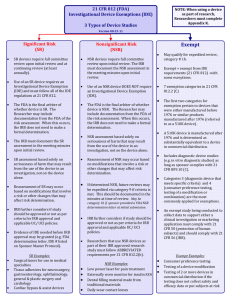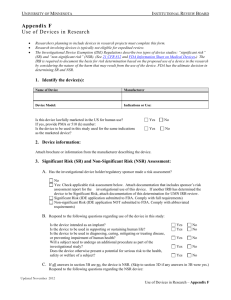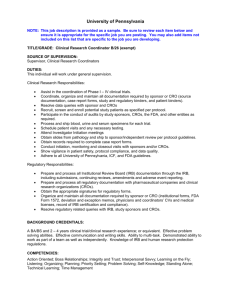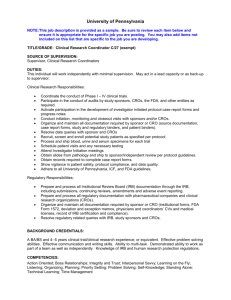Information Sheet Guidance For IRBs, Clinical Investigators, and Sponsors
advertisement
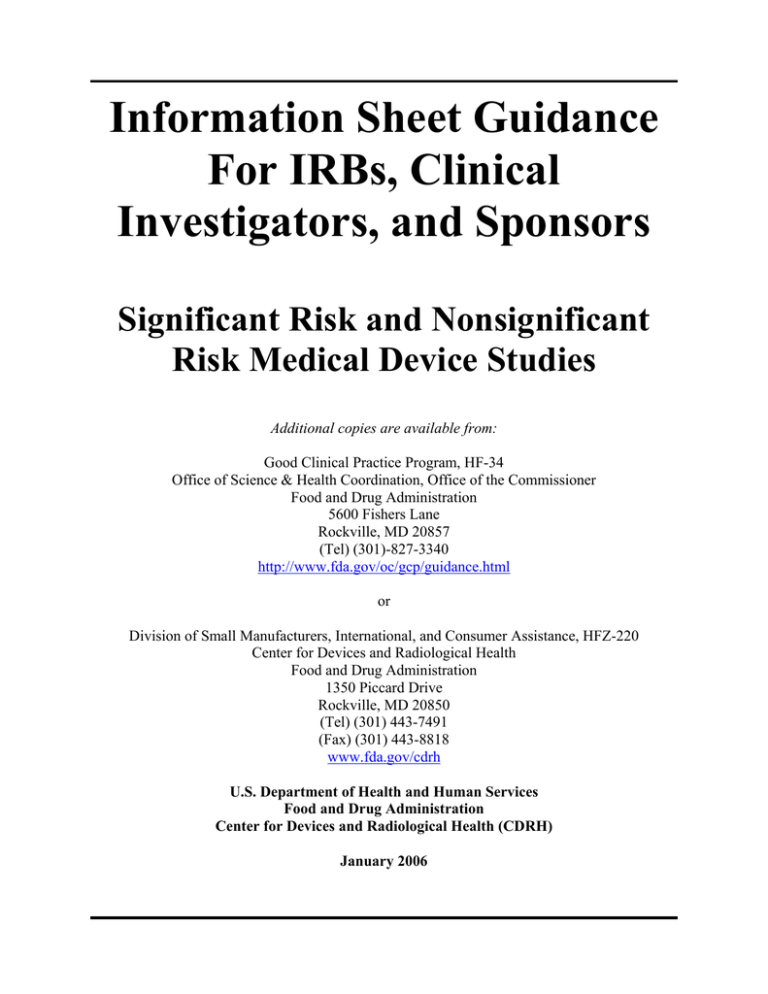
Information Sheet Guidance For IRBs, Clinical Investigators, and Sponsors Significant Risk and Nonsignificant Risk Medical Device Studies Additional copies are available from: Good Clinical Practice Program, HF-34 Office of Science & Health Coordination, Office of the Commissioner Food and Drug Administration 5600 Fishers Lane Rockville, MD 20857 (Tel) (301)-827-3340 http://www.fda.gov/oc/gcp/guidance.html or Division of Small Manufacturers, International, and Consumer Assistance, HFZ-220 Center for Devices and Radiological Health Food and Drug Administration 1350 Piccard Drive Rockville, MD 20850 (Tel) (301) 443-7491 (Fax) (301) 443-8818 www.fda.gov/cdrh U.S. Department of Health and Human Services Food and Drug Administration Center for Devices and Radiological Health (CDRH) January 2006 Contains Nonbinding Recommendations TABLE OF CONTENTS I. INTRODUCTION............................................................................................................. 2 II. BACKGROUND ............................................................................................................... 2 III. SIGNIFICANT RISK AND NONSIGNIFICANT RISK DEVICE STUDIES ........... 3 A. What is a Significant Risk Device Study?.................................................................................... 3 B. What is a Nonsignificant Risk Device Study? ............................................................................. 3 C. Who Decides Whether a Device Study is SR or NSR? ............................................................... 3 D. What are the Major Differences Between SR and NSR Device Studies? ................................. 4 IV. WHAT ARE THE SPONSOR'S RESPONSIBILITIES WHEN INITIATING A DEVICE STUDY? ........................................................................................................................ 4 A. For Nonsignificant Risk Device Studies ....................................................................................... 4 B. For Significant Risk Device Studies ............................................................................................. 5 V. WHAT ARE THE IRB'S RESPONSIBILITIES WHEN IT RECEIVES A DEVICE STUDY FOR REVIEW?.............................................................................................................. 5 VI. WHAT SHOULD IRBS CONSIDER WHEN MAKING THE SR AND NSR DETERMINATION? ................................................................................................................... 6 VII. HOW DOES AN IRB DOCUMENT THE SR OR NSR DETERMINATION? ......... 7 VIII. WHAT SHOULD AN IRB DO FOR DEVICE STUDIES THAT ARE EXEMPT FROM THE REQUIREMENTS OF THE IDE REGULATIONS (21 CFR §812.2(C))?...... 7 A. Difference Between NSR and Minimal Risk Determinations .................................................... 8 B. Difference Between SR/NSR Determinations and Approval Decisions .................................... 8 IX. WHAT ARE FDA'S RESPONSIBILITIES? ................................................................. 8 X. EXAMPLES OF NSR AND SR DEVICES ................................................................... 8 A. Nonsignificant Risk Devices .......................................................................................................... 9 B. Significant Risk Devices .............................................................................................................. 10 1 Contains Nonbinding Recommendations Information Sheet Guidance For IRBs, Clinical Investigators, and Sponsors1 Significant Risk and Nonsignificant Risk Medical Device Studies This guidance represents the Food and Drug Administration's (FDA's) current thinking on this topic. It does not create or confer any rights for or on any person and does not operate to bind FDA or the public. You can use an alternative approach if it satisfies the requirements of the applicable statutes and regulations. If you want to discuss an alternative approach, contact the FDA staff responsible for implementing this guidance. If you cannot identify the appropriate FDA staff, call the appropriate number listed on the title page of this guidance. I. INTRODUCTION This guidance is intended to provide advice to sponsors, clinical investigators, and institutional review boards (IRBs) on how to determine the differences between significant risk and nonsignificant risk medical device studies. This document supersedes Significant Risk and Nonsignificant Risk Medical Device Studies (September 1998) Office of Health Affairs, Food and Drug Administration. This document was revised to update the list of examples of significant and nonsignificant risk devices, to clarify the IRB’s responsibilities when making the risk determination for investigational medical devices, and to make the guidance consistent with the Agency’s good guidance practices regulations (21 CFR 10.115). FDA's guidance documents, including this guidance, do not establish legally enforceable responsibilities. Instead, guidances describe the Agency's current thinking on a topic and should be viewed only as recommendations, unless specific regulatory or statutory requirements are cited. The use of the word should in Agency guidances means that something is suggested or recommended, but not required. II. BACKGROUND 1 This guidance document was developed by the Good Clinical Practice Program in coordination with the Agency Centers. 2 Contains Nonbinding Recommendations The Investigational Device Exemptions (IDE) regulation (21 CFR 812) describes three types of device studies: significant risk (SR), nonsignificant risk (NSR), and exempt studies. In this guidance, we discuss the two types of studies that are subject to the IDE regulation – the SR and NSR studies. For information on studies that are exempt from the IDE regulation, see the Information Sheet Guidance entitled, “Frequently Asked Questions About Medical Devices.” III. SIGNIFICANT RISK AND NON-SIGNIFICANT RISK DEVICE STUDIES A. What is a Significant Risk Device Study? Under 21 CFR 812.3(m), an SR device means an investigational device that: • • • • Is intended as an implant and presents a potential for serious risk to the health, safety, or welfare of a subject; Is purported or represented to be for use supporting or sustaining human life and presents a potential for serious risk to the health, safety, or welfare of a subject; Is for a use of substantial importance in diagnosing, curing, mitigating, or treating disease, or otherwise preventing impairment of human health and presents a potential for serious risk to the health, safety, or welfare of a subject; or Otherwise presents a potential for serious risk to the health, safety, or welfare of a subject. B. What is a Nonsignificant Risk Device Study? An NSR device study is one that does not meet the definition for an SR device study. C. Who Decides Whether A Device Study is SR or NSR? Sponsors are responsible for making the initial risk determination and presenting it to the IRB. FDA is also available to help the sponsor, clinical investigator, and IRB in making the risk determination.2 Unless FDA has already made a risk determination for the study, the IRB must review the sponsor's SR or NSR determination for every investigational medical device study reviewed and modify the determination if the IRB disagrees with the sponsor. If FDA has already made the SR or NSR determination for the study, the agency's determination is final. FDA is available to help the IRB when making its risk determination. (Also, see section VII. “How does an IRB document the SR or NSR determination?”) 2 See the guidance entitled, “Procedures for Handling Inquiries Regarding the Need for an Investigational Device Exemptions Application for Research Involving Medical Devices.” This guidance may be found at: www.fda.gov/cdrh/ode/blue-ide-d01-1.html 3 Contains Nonbinding Recommendations FDA is the final arbiter as to whether a device study is SR or NSR and makes the determination when an IDE is submitted to FDA or if asked by the sponsor, clinical investigator, or IRB. See 21 CFR § 812.2(b)(1) D. What are the Major Differences Between SR And NSR Device Studies? The major differences between SR and NSR studies are in the IDE approval process and in the sponsor’s record keeping and reporting requirements, as outlined below. 1. Significant Risk (SR) Device Studies • SR device studies must follow all the IDE regulations at 21 CFR 812. • SR device studies must have an IDE application approved by FDA before they may proceed. 2. Nonsignificant Risk (NSR) Device Studies • NSR device studies must follow the abbreviated requirements at 21 CFR 812.2(b). • These abbreviated requirements address labeling, IRB approval, informed consent, monitoring, records, reports, and prohibition against promotion. However, there is no need to make progress reports or final reports to FDA. • NSR device studies do not have to have an IDE application approved by FDA. • Sponsors and IRBs do not have to report the IRB approval of an NSR device study to FDA. This means that an IRB may approve an NSR device study and an investigator may conduct the study without FDA knowing about it. • An IRB’s NSR determination is important because the IRB serves as the FDA’s surrogate for review, approval, and continuing review of the NSR device studies. An NSR device study may start at the institution as soon as the IRB reviews and approves the study and without prior approval by FDA. IV. WHAT ARE THE SPONSOR'S RESPONSIBILITIES WHEN INITIATING A DEVICE STUDY? A. • For Nonsignificant Risk Device Studies If the sponsor identifies a study as NSR, the sponsor must provide the reviewing IRB an explanation of its determination (21 CFR 812.2(b)(1)(ii)) and should provide any other information that may help the IRB in evaluating the risk of the study. For example, a 4 Contains Nonbinding Recommendations description of the device, reports of prior investigations with the device, the proposed investigational plan, subject selection criteria, and other information the IRB may need. • If FDA has determined that the study is NSR, the sponsor should so inform the IRB. By providing such risk determination information to the IRB, the IRB’s workload should be reduced and the review process should be facilitated. B. For Significant Risk Device Studies • The sponsor must submit an IDE application to FDA and obtain the agency’s approval of the study. (See 21 CFR 812.20(a)(1) and (2)) • The sponsor must advise its clinical investigators about the SR status and obtain their agreement to comply with the applicable regulations governing such studies (i.e., 21 CFR Parts, 50, 56, 812) (See 21 CFR 812.43(c)(4)(i)). Sponsors should provide the IDE number and/or a copy of the IDE approval letter to the IRB when requested. • Sponsors may send their SR device study to an IRB for review before the IDE application is approved by FDA. However, FDA cautions that an SR device study may not begin until FDA approves the IDE. V. WHAT ARE THE IRB’S RESPONSIBILITIES WHEN IT RECEIVES A DEVICE STUDY FOR REVIEW? • IRBs should have standard operating procedures that explain how the IRB makes SR and NSR determinations and that the decision should be documented. FDA considers this determination to be part of the IRB’s responsibilities for conducting its initial review of a study. (See 21 CFR 56.108) • IRBs should make the SR or NSR determination about a study by reviewing relevant information at a convened meeting. This information includes the description of the device, reports of prior investigations conducted with the device, the proposed investigational plan, and subject selection criteria. The sponsor should provide the IRB with a risk assessment and the rationale used in making its SR or NSR determination. • An IRB may agree or disagree with the sponsor’s initial NSR assessment. • If the IRB determines the study is NSR, the IRB may approve the study using the criteria at 21 CFR 56.111. The study may begin without submission of an IDE application to FDA. • If the IRB disagrees with the sponsor’s NSR assessment and decides the study is SR, the IRB must tell the clinical investigator, and where appropriate, the sponsor. (See 21 CFR 812.66) 5 Contains Nonbinding Recommendations • An IRB may approve the study as an SR device study, but the study may not begin until FDA approves the sponsor’s IDE application. • To facilitate the IRB’s review of the study, an IRB may ask the sponsor for proof (i.e., a copy of FDA’s approval or conditional approval letter) that an SR study has an FDA-approved IDE application. • The IRB should document its SR/NSR determination in the IRB meeting minutes. VI. WHAT SHOULD IRBS CONSIDER WHEN MAKING THE SR AND NSR DETERMINATION? • What is the basis for the risk determination? The risk determination is based on the proposed use of a device in an investigation, and not on the device alone. • What is the nature of harm that may result from use of the device? SR studies are those that present a potential for serious risk to the health, safety, or welfare of a subject. See the question “What is a Significant Risk Device Study?” for further information. • Will the subject need to undergo an additional procedure as part of the investigational study, for example, a surgical procedure? IRBs should consider the potential harm the procedure could cause as well as the potential harm caused by the device. Several examples follow: 1. The study of a change to a commercially available pacemaker (e.g., new leads, battery pack, or software) poses an SR because the device is used to support or sustain human life and it presents a potential for serious harm to the subjects. This is true even though the changed pacemaker may potentially pose less risk, or only slightly greater risk, in comparison to the commercially available model. 2. The study of an extended wear contact lens is SR because wearing the lens continuously overnight while sleeping presents a potential for injuries not normally seen with daily wear lenses, which are NSR. 3. An investigational study of a sensor pad to find out if the device can detect the electrical activity of the spinal cord may be NSR, if the study of the sensor pad takes place at the same time as the planned surgical repair of the spinal cord, if all the following are true: - repair of the spinal cord would occur anyway; 6 Contains Nonbinding Recommendations - - VII. the sensor pad does not present a potential for serious risk to the health, safety, or welfare of a subject (for example, placing the pad would not prolong or interfere with the operation); the sensor pad is not implanted; the pad is not of substantial importance in diagnosing, curing, mitigating or treating disease. HOW DOES AN IRB DOCUMENT THE SR OR NSR DETERMINATION? The IRB should write its decision in the meeting minutes. The minutes should describe the IRB’s reason for its SR or NSR determination and may also include the documentation used to establish the IDE status for the study. For an SR determination, such documentation may include, for example, a copy of the IDE approval or conditional approval letter from FDA. For an NSR determination, the documentation may include FDA's NSR determination where the agency has made the determination. FDA will issue an NSR letter upon written request. VIII. WHAT SHOULD AN IRB DO FOR DEVICE STUDIES THAT ARE EXEMPT FROM THE REQUIREMENTS OF THE IDE REGULATIONS (21 CFR 812.2(C))? For studies that are exempt from the IDE regulations, the IRB does not need to decide whether the study poses a significant risk or nonsignificant risk. However, the IRB must still review the study in accordance with the IRB regulations before the investigation may begin. IRBs should understand distinctions between certain important concepts that are frequently confused: A. Difference between NSR and Minimal Risk Determinations IRBs should not confuse their responsibility to make an SR/NSR determination for a device study with the concept of “minimal risk.” “Minimal Risk” is a term used in the IRB regulations in part to identify certain studies that IRBs may approve through an expedited review procedure. For a device study to be eligible for expedited review, it must be an NSR study AND present no more than minimal risk to the subject. (See 21 CFR 56.110) B. Difference Between SR/NSR Determinations and Approval Decisions IRBs should not confuse their responsibility to review and approve research for conduct at a clinical site with the SR/NSR determination. IRBs make the SR/NSR determination before the IRB conducts its review of the study under Part 56. The judgment about whether a study poses a significant risk or nonsignificant risk is based on the significance of the potential harm that may result from participation in the study, including the use of the device; whereas 7 Contains Nonbinding Recommendations the IRB’s decision to approve a study for implementation is based on the study’s risk-benefit assessment. IX. WHAT ARE FDA’S RESPONSIBILITIES? • As discussed, FDA is the final arbiter in deciding whether a device study poses a significant or nonsignificant risk. It should be noted, however, that FDA generally only sees those studies that sponsors submit to the agency or those studies for which an IRB or clinical investigator asks for FDA’s opinion. • If FDA disagrees with an IRB’s NSR decision and determines that the study poses a significant risk, the sponsor may not begin their study until FDA approves an IDE. (See 21 CFR 812.42) • If a sponsor submits an IDE to FDA because the sponsor presumed it to be an SR study, and FDA determines that the device study poses a nonsignificant risk, FDA will tell the sponsor in writing. The study may then be reviewed by the IRB as an NSR study. X. EXAMPLES OF NSR AND SR DEVICES The following examples may help sponsors and IRBs in making SR and NSR determinations. The list includes many commonly studied medical devices. Inclusion of a device in the NSR list is not a final determination because the evaluation of risk must reflect the proposed use of a device in a study. A. • • • • • • • • • • Nonsignificant Risk Devices Caries Removal Solution Contact Lens Solutions intended for use directly in the eye (e.g., lubricating/rewetting solutions) using active ingredients or preservation systems with a history of prior ophthalmic/contact lens use or generally recognized as safe for ophthalmic use Conventional Gastroenterology and Urology Endoscopes and/or Accessories Conventional General Hospital Catheters (long-term percutaneous, implanted, subcutaneous and intravascular) Conventional Implantable Vascular Access Devices (Ports) Conventional Laparoscopes, Culdoscopes, and Hysteroscopes Daily Wear Contact Lenses and Associated Lens Care Products not intended for use directly in the eye (e.g., cleaners; disinfecting, rinsing and storage solutions) Dental Filling Materials, Cushions or Pads made from traditional materials and designs Denture Repair Kits and Realigners Digital Mammography 8 Contains Nonbinding Recommendations • • • • • • • • • • • • • • • • • • • • Electroencephalography (e.g., new recording and analysis methods, enhanced diagnostic capabilities, measuring depth of anesthesia if anesthetic administration is not based on device output) Externally Worn Monitors for Insulin Reactions Functional Non-Invasive Electrical Neuromuscular Stimulators General Biliary Catheters General Urological Catheters (e.g., Foley and diagnostic catheters) for short term use (< 28 days) Jaundice Monitors for Infants Low Power Lasers for treatment of pain Magnetic Resonance Imaging (MRI) Devices within FDA specified parameters Manual Image Guided Surgery Menstrual Pads (Cotton or Rayon, only) Menstrual Tampons (Cotton or Rayon, only) Nonimplantable Electrical Incontinence Devices Nonimplantable Male Reproductive Aids with no components that enter the vagina Ob/Gyn Diagnostic Ultrasound within FDA approved parameters Partial Ossicular Replacement Prosthesis (PORP) Total Ossicular Replacement Prosthesis (TORP) Transcutaneous Electric Nerve Stimulation (TENS) Devices for treatment of pain (except for chest pain/angina) Ureteral Stents Urethral Occlusion Device for less than 14 days Wound Dressings, excluding absorbable hemostatic devices and dressings (also excluding Interactive Wound and Burn Dressings that aid or are intended to aid in the healing process) B. • • • • • • Significant Risk Devices 1. General Medical Use Catheters for General Hospital Use - except for conventional long-term percutaneous, implanted, subcutaneous and intravascular Collagen Implant Material for use in ear, nose and throat, orthopedics, plastic surgery, urological and dental applications Surgical Lasers for use in various medical specialties Tissue Adhesives for use in neurosurgery, gastroenterology, ophthalmology, general and plastic surgery, and cardiology 2. Anesthesiology Breathing Gas Mixers Bronchial Tubes 9 Contains Nonbinding Recommendations • • • • • • • • • • • • • • • • • • • • • • • • • • • • • • • • • Electroanesthesia Apparatus Epidural and Spinal Catheters Epidural and Spinal Needles Esophageal Obturators Gas Machines for anesthesia or analgesia High Frequency Ventilators greater than 150 BPM Rebreathing Devices Respiratory Ventilators and new modes of ventilation Tracheal Tubes 3. Cardiovascular Annuloplasty Rings Aortic and Mitral Valvuloplasty Catheters Arterial Embolization Devices Atherectomy and Thrombectomy Catheters Cardiac Assist Devices: artificial hearts, ventricular assist devices, intra-aortic balloon pumps, cardiomyoplasty devices Cardiac Bypass Devices: oxygenators, cardiopulmonary blood pumps, axial flow pumps, closed chest devices (except Class I cardiovascular surgical instruments), heat exchangers, catheters/cannulae, tubing, arterial filters, reservoirs Cardiac Mapping and Ablation Catheters Cardiac Pacemaker/Pulse Generators: antitachycardia, esophageal, external transcutaneous, implantable Cardiopulmonary Resuscitation (CPR) Devices Cardiovascular Intravascular (vena cava) Filters Coronary Artery Retroperfusion Systems Distal Embolic Protection Devices Extracorporeal Counterpulsation Devices Extracorporeal Membrane Oxygenators (ECMO) Implantable Cardioverters/Defibrillators Intravascular Brachytherapy Devices Intravascular Stents Laser Angioplasty Catheters Organ Storage/Transport Units Pacing Leads Percutaneous Conduction Tissue Ablation Electrodes Percutaneous Transluminal Angioplasty Catheters Replacement Heart Valves Transcatheter Cardiac Occluders for atrial and ventricular septal defects, patent foramen ovale and patent ductus arteriosus 10 Contains Nonbinding Recommendations • • • • Transmyocardial Revascularization, Percutaneous Myocardial Revascularization Devices Ultrasonic Angioplasty Catheters Vascular and Arterial Graft Prostheses Vascular Hemostasis Devices • • 4. Dental Absorbable Materials to aid in the healing of periodontal defects and other maxillofacial applications Bone Morphogenic Proteins with and without bone, e.g., Hydroxyapatite (HA) Dental Lasers for hard tissue applications Endosseous Implants and associated bone filling and augmentation materials used in conjunction with the implants Subperiosteal Implants Temporomandibular Joint (TMJ) Prostheses • • • • • • • • • • • • 5. Ear, Nose And Throat Absorbable Gelatin Sponge Auditory Brainstem Implants Cochlear Implants Endolymphatic Shunt Tubes with or without valve ENT Cements/Adhesives Implantable Bone Conduction Hearing Aids Implantable Middle Ear Hearing Device Injectable Teflon Paste Laryngeal Implants Synthetic Polymer Materials Tissue Autofluorescent Devices Vocal Cord Medialization (Augmentation) Devices • • • • • • • • • • 6. Gastroenterology And Urology Anastomosis Devices Balloon Dilation Catheters for benign prostatic hyperplasia (BPH) Biliary Stents Components of Water Treatment Systems for Hemodialysis Dialysis Delivery Systems Electrical Stimulation Devices for sperm collection Embolization Devices for general urological use Extracorporeal Circulation Systems Extracorporeal Hyperthermia Systems Extracorporeal Photopheresis Systems • • • • 11 Contains Nonbinding Recommendations • • • • • • • • • • • • • • • • • • • Femoral, Jugular and Subclavian Catheters Hemodialyzers Hemofilters Implantable Electrical Urinary Incontinence Systems Implantable Penile Prostheses Injectable Bulking Agents for incontinence Lithotripters (e.g., electrohydraulic extracorporeal shock-wave, laser, powered mechanical, ultrasonic) Mechanical/Hydraulic Urinary Incontinence Devices Penetrating External Penile Rigidity Devices with components that enter the vagina Peritoneal Dialysis Devices Peritoneal Shunt Plasmapheresis Systems Prostatic Hyperthermia or Thermal Ablation Devices Retention Type (Foley) Balloon Catheters for long term use (> 28 days) Suprapubic Urological Catheters and accessories Urethral Occlusion Devices for greater than 14 days use Urethral Sphincter Prostheses Urological Catheters with anti-microbial coatings Urological Stents (e.g., urethral, prostate, etc.) • • • • • • • • 7. General And Plastic Surgery Absorbable Adhesion Barrier Devices Absorbable Hemostatic Agents Artificial Skin and Interactive Wound and Burn Dressings Breast Implants Injectable Collagen Implantable Craniofacial Prostheses Repeat Access Devices for surgical procedures Sutures • • 8. General Hospital Implantable Vascular Access Devices (Ports) - if new routes of administration or new design Infusion Pumps (implantable and closed-loop - depending on the infused drug) • • • • 9. Neurological Electroconvulsive Therapy (ECT) Devices Hydrocephalus Shunts Implanted Intracerebral/Subcortical Stimulators Implanted Intracranial Pressure Monitors 12 Contains Nonbinding Recommendations • • • Implanted Spinal Cord and Nerve Stimulators and Electrodes Neurological Catheters (e.g., cerebrovascular, occlusion balloon, etc.) Transcutaneous Electric Nerve Stimulation (TENS) Devices for treatment of chest pain/angina • • • • • • • • • • • 10. Obstetrics And Gynecology Abdominal Decompression Chamber Antepartum Home Monitors for Non-Stress Tests Antepartum Home Uterine Activity Monitors Catheters for Chorionic Villus Sampling (CVS) Catheters Introduced into the Fallopian Tubes Cervical Dilation Devices Contraceptive Devices: o Cervical Caps o Condoms (for men) made from new materials (e.g., polyurethane) o Contraceptive In Vitro Diagnostics (IVDs) o Diaphragms o Female Condoms o Intrauterine Devices (IUDs) o New Electrosurgical Instruments for Tubal Coagulation o New Devices for Occlusion of the Vas Deferens o Sponges o Tubal Occlusion Devices (Bands or Clips) Cryomyolysis Devices to Prevent Post-op Pelvic Adhesions Embryoscopes and Devices intended for fetal surgery Endometrial Ablation Systems Falloposcopes and Falloposcopic Delivery Systems Fundal Pressure Belt (for vaginal assisted delivery) Gamete and Embryo Surgical Systems Intrapartum Fetal Monitors using new physiological markers New Devices to Facilitate Assisted Vaginal Delivery Operative Hysteroscopy and Laparoscopy Uterine Artery Embolization • • • 11. Ophthalmics Aniridia Intraocular Lenses (IOLs) or Rings (for iris reconstruction) Capsular Tension Rings Class III Ophthalmic Lasers • • • • • • • 13 Contains Nonbinding Recommendations • • • • • • • • • • • • Contact Lens Solutions intended for direct instillation (e.g., lubrication/rewetting solutions) in the eye using new active agents or preservatives with no history of prior ophthalmic/contact lens use or not generally recognized as safe for ophthalmic use Corneal Storage Media Extended Wear Contact Lens (i.e., including a single overnight use) Glaucoma Treatment Devices (e.g., trabeculoplasty devices, devices that treat ciliary bodies, devices that raise or lower intraocular pressure, aqueous shunt/drainage devices, etc.) Implants for Refractive Purposes (e.g., intraocular lenses, corneal implants, scleral expansion bands, etc.) Intraocular Lenses (IOLs) Keratoprostheses Refractive Surgical Devices (e.g., lasers, electrical current devices, thermal and non-thermal keratoplasty devices, ablation devices, expansion rings, treatment of ciliary bodies, etc.) Retinal Disease Treatment Devices (e.g., electrical stimulation devices to treat macular degeneration, lasers to ablate epiretinal membranes and vitreous strands, etc.) Retinal Prosthesis (implant) Retinal Reattachment Devices (e.g., fluids, gases, perfluorocarbons, perfluorpropane, silicone oil, sulfur hexafluoride, balloon catheter for retinal reattachment) Viscosurgical Fluids (viscoelastics) • • • • • • • 12. Orthopedics And Restorative Anti-Adhesion Gels Bone Growth Stimulators Bone Morphogenetic Proteins/Biodegradable Scaffolds combination products, with or without allograft/autograft combinations and with or without metallic implant Bone Void Fillers (hydroxyapatite and other materials) Bovine Collagen Meniscus Implants Computer Guided Robotic Surgery Implantable Peripheral Neuromuscular Stimulators Implantable Prostheses (ligament, tendon, hip, knee, finger) Implantable Spinal Devices Injectable Sodium Hyaluronate • • 13. Radiology Boron Neutron Capture Therapy Hyperthermia Systems and Applicators • • • Also see the FDA Information Sheet Guidance on “Frequently Asked Questions about Medical Devices.” 14
